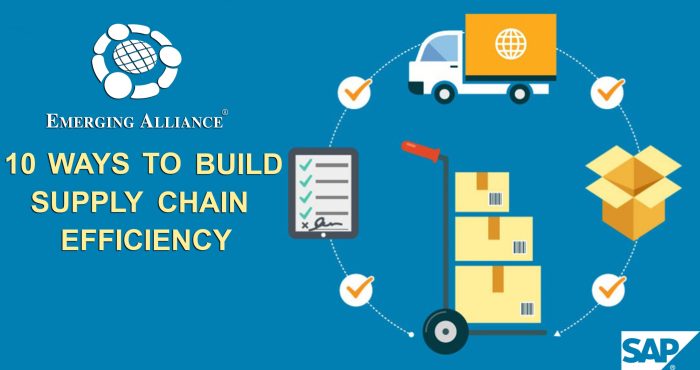
Optimizing supply chains for peak efficiency is no longer a luxury; it’s a necessity in today’s dynamic global marketplace. From inventory management to risk mitigation, businesses are constantly seeking innovative strategies to streamline operations, reduce costs, and enhance responsiveness. This exploration delves into the multifaceted world of supply chain strategies, examining key techniques and technologies that empower organizations to achieve unprecedented levels of efficiency and resilience.
This examination will cover various aspects, including inventory management techniques like Just-in-Time (JIT) and Vendor Managed Inventory (VMI), the crucial role of supplier relationship management (SRM), the optimization of transportation and logistics, and the transformative impact of technology such as AI, blockchain, and the Internet of Things (IoT). We will also consider the importance of sustainability, risk management, and the strategic use of data analytics for informed decision-making.
The goal is to provide a comprehensive understanding of how businesses can build robust, efficient, and future-proof supply chains.
Supply Chain Visibility and Data Analytics

Effective supply chain management hinges on possessing a clear and comprehensive understanding of the entire process, from raw material sourcing to final product delivery. Real-time visibility and robust data analytics are crucial for achieving this understanding and driving efficiency improvements. Without them, organizations operate blindly, reacting to problems rather than proactively preventing them.Real-time visibility allows for immediate identification of disruptions and deviations from planned schedules, enabling swift corrective action.
This proactive approach minimizes delays, reduces costs, and enhances customer satisfaction. Data analytics, in turn, provides the tools to dissect this real-time data, uncovering hidden patterns and insights that inform strategic decision-making.
Real-Time Visibility in Supply Chain Operations
Real-time visibility into supply chain operations is paramount for efficient management. It provides a dynamic, up-to-the-minute picture of inventory levels, transportation status, production schedules, and other key factors. This allows for immediate response to unexpected events such as supplier delays, transportation disruptions, or quality issues. For example, a sudden surge in demand can be anticipated and addressed before it leads to stockouts, while a shipment delay can be mitigated by rerouting or finding alternative suppliers.
The result is a more agile and responsive supply chain, capable of adapting to unforeseen circumstances with minimal disruption.
Data Analytics for Supply Chain Improvement
Data analytics plays a vital role in transforming raw supply chain data into actionable insights. By analyzing historical and real-time data, organizations can identify bottlenecks, inefficiencies, and areas for improvement. Techniques such as predictive modeling can forecast future demand, enabling proactive inventory management and optimized production planning. For instance, analyzing historical sales data alongside weather patterns might reveal a strong correlation between rainfall and increased demand for umbrellas, allowing for preemptive stock adjustments.
Furthermore, anomaly detection algorithms can pinpoint unusual patterns that might signal potential problems, such as a sudden increase in shipping costs or a decline in supplier performance.
Key Performance Indicators (KPIs) for Supply Chain Efficiency
Monitoring key performance indicators (KPIs) is essential for tracking progress and identifying areas needing attention. Effective KPIs provide quantifiable metrics for evaluating supply chain performance. Some common KPIs include:
- On-Time Delivery Rate: Measures the percentage of orders delivered on or before the scheduled delivery date. A consistently low rate indicates potential issues with transportation, production, or planning.
- Inventory Turnover Rate: Shows how quickly inventory is sold or used. A high turnover rate suggests efficient inventory management, while a low rate may indicate overstocking or slow-moving inventory.
- Order Fulfillment Cycle Time: Measures the time it takes to fulfill an order, from receipt to delivery. Reducing this time improves customer satisfaction and operational efficiency.
- Supply Chain Cost as a Percentage of Revenue: Tracks the overall cost of the supply chain relative to revenue. A high percentage indicates potential areas for cost reduction.
Regularly tracking and analyzing these KPIs provides a clear picture of supply chain health, guiding improvements and ensuring continuous optimization. For example, a consistently low on-time delivery rate might indicate a need for improved transportation management or more accurate forecasting.
The Role of Outsourcing and Offshoring
Outsourcing and offshoring are increasingly prevalent strategies in supply chain management, offering the potential for significant cost savings and efficiency gains. However, these strategies also present considerable risks, requiring careful consideration and strategic planning to ensure successful implementation. This section will explore the advantages and disadvantages of these approaches, examine various outsourcing models, and analyze examples of both effective and ineffective implementations.Outsourcing involves contracting a third-party provider to perform specific functions within the supply chain, while offshoring involves relocating these functions to a different country.
Both strategies aim to leverage external expertise and resources to optimize operations, but they differ in their geographic scope and associated challenges.
Advantages and Disadvantages of Outsourcing and Offshoring
Outsourcing and offshoring offer several compelling advantages, including reduced labor costs, access to specialized expertise, and increased operational flexibility. Companies can focus on core competencies while entrusting non-core activities to specialized providers. This can lead to significant cost reductions, particularly in labor-intensive processes. Furthermore, outsourcing can provide access to a wider talent pool and advanced technologies, potentially boosting efficiency and innovation.
However, risks exist, such as potential quality control issues, communication barriers, loss of control over operations, and increased dependence on external providers. Offshoring, in particular, adds the complexities of geographical distance, differing regulatory environments, and potential political and economic instability. A thorough cost-benefit analysis is crucial before implementing either strategy.
Comparison of Outsourcing Models
Different outsourcing models exist, each with its own implications for efficiency. For example, a “full-service” model outsources a complete function, such as logistics or manufacturing, to a single provider. This can simplify management but increases reliance on the provider. A “selective outsourcing” model, on the other hand, outsources individual tasks or processes to multiple providers, offering greater flexibility and control but potentially increasing complexity.
A “joint venture” model involves a collaborative partnership with an external provider, combining resources and expertise to achieve shared goals. The optimal model depends on factors such as the complexity of the outsourced function, the company’s risk tolerance, and the availability of suitable providers.
Examples of Successful and Unsuccessful Outsourcing Strategies
Successful outsourcing often involves meticulous planning, clear communication, robust contract management, and ongoing monitoring of performance. For instance, Nike’s successful outsourcing of manufacturing to factories in Asia allowed them to focus on design and marketing while leveraging lower labor costs. Conversely, unsuccessful outsourcing can result from inadequate due diligence, poor communication, and a lack of effective performance monitoring.
Companies that fail to establish clear expectations, performance metrics, and dispute resolution mechanisms often experience difficulties. A well-known example of an unsuccessful outsourcing strategy is the outsourcing of IT services by many companies in the early 2000s, where inadequate planning and management led to significant disruptions and cost overruns. Careful selection of providers, robust contract negotiations, and continuous performance monitoring are critical to mitigating these risks.
Understanding the Supply Chain

A robust understanding of the supply chain is crucial for implementing effective efficiency strategies. This involves recognizing the various stages, key players, and the intricate flow of goods and information from origin to final consumption. A well-defined and managed supply chain can significantly reduce costs, improve delivery times, and enhance overall customer satisfaction.The supply chain encompasses a complex network of activities and actors working together to deliver a product or service to the end consumer.
Efficient supply chain management requires a holistic view of these interconnected processes and the ability to optimize each stage for maximum efficiency.
Stages of a Typical Supply Chain
The typical supply chain can be broken down into several key stages. These stages, while often presented linearly, are highly interconnected and interdependent. Disruptions in one stage can significantly impact the entire process. Effective supply chain management requires monitoring and managing each stage proactively.
- Planning: This initial stage involves forecasting demand, sourcing raw materials, and designing production plans. Accurate demand forecasting is crucial for avoiding overstocking or stockouts.
- Sourcing: This involves selecting and managing suppliers for raw materials, components, and services. Supplier relationship management is critical for ensuring timely delivery and quality.
- Manufacturing/Production: This stage focuses on transforming raw materials into finished goods. Efficient production processes are key to minimizing waste and maximizing output.
- Packaging: Products are prepared for transportation and storage. Effective packaging protects the product and optimizes shipping space.
- Warehousing and Storage: Finished goods are stored before distribution to customers. Efficient warehouse management minimizes storage costs and ensures timely order fulfillment.
- Transportation: This involves moving goods from the manufacturing facility to warehouses and ultimately to customers. Selecting appropriate transportation modes is vital for cost-effectiveness and timely delivery.
- Distribution: This stage focuses on getting the product to the end customer, whether through direct sales, retail channels, or other distribution networks.
- Customer Service: This encompasses handling customer inquiries, returns, and complaints. Excellent customer service is crucial for building brand loyalty.
Key Players and Their Roles
Numerous players contribute to the success of a supply chain. Effective collaboration and communication among these players are essential for smooth operations. Understanding the roles of each participant allows for better coordination and optimization.
- Suppliers: Provide raw materials, components, or services.
- Manufacturers: Transform raw materials into finished goods.
- Distributors: Facilitate the movement of goods from manufacturers to retailers or customers.
- Retailers: Sell finished goods to end consumers.
- Logistics Providers: Manage transportation, warehousing, and other logistical aspects.
- Customers: The end users of the product or service.
Simplified Supply Chain Process Flow Chart
The following describes a simplified supply chain flow chart illustrating the movement of a product from raw material sourcing to customer delivery.The chart begins with a “Raw Materials” box. An arrow points from this box to a “Manufacturing” box, representing the transformation of raw materials into finished goods. From “Manufacturing,” an arrow leads to a “Warehouse” box, where finished goods are stored.
Next, an arrow points from “Warehouse” to a “Distribution Center” box, highlighting the movement of goods to a central distribution point. Finally, an arrow connects “Distribution Center” to a “Customer” box, signifying the delivery of the product to the end consumer. Feedback loops, represented by dashed lines, connect the “Customer” box back to the “Planning” stage (which could be considered a separate box before “Raw Materials”), illustrating the importance of customer feedback in influencing future planning and sourcing decisions.
This simplified model showcases the linear progression while acknowledging the iterative nature of supply chain management.
Ultimately, achieving supply chain efficiency requires a holistic approach that integrates best practices across all operational areas. By strategically leveraging technology, fostering strong supplier relationships, optimizing inventory management, and proactively managing risks, businesses can unlock significant cost savings, improve customer satisfaction, and gain a competitive edge. The journey towards an efficient supply chain is an ongoing process of continuous improvement, adaptation, and innovation, requiring a commitment to data-driven decision-making and a willingness to embrace new technologies and methodologies.
General Inquiries
What is the bullwhip effect and how can it be mitigated?
The bullwhip effect refers to amplified demand variability as you move upstream in the supply chain. Mitigation strategies include improving demand forecasting accuracy, enhancing information sharing with suppliers, and implementing collaborative planning, forecasting, and replenishment (CPFR) programs.
How can blockchain technology enhance supply chain transparency?
Blockchain provides immutable records of transactions and product movement, improving traceability and transparency. This allows for better tracking of goods, identification of counterfeits, and enhanced accountability throughout the supply chain.
What are some key considerations when outsourcing logistics?
Key considerations include evaluating the third-party logistics provider’s (3PL) capabilities, experience, and technology, negotiating clear service level agreements (SLAs), ensuring data security and integration, and establishing robust performance monitoring mechanisms.





